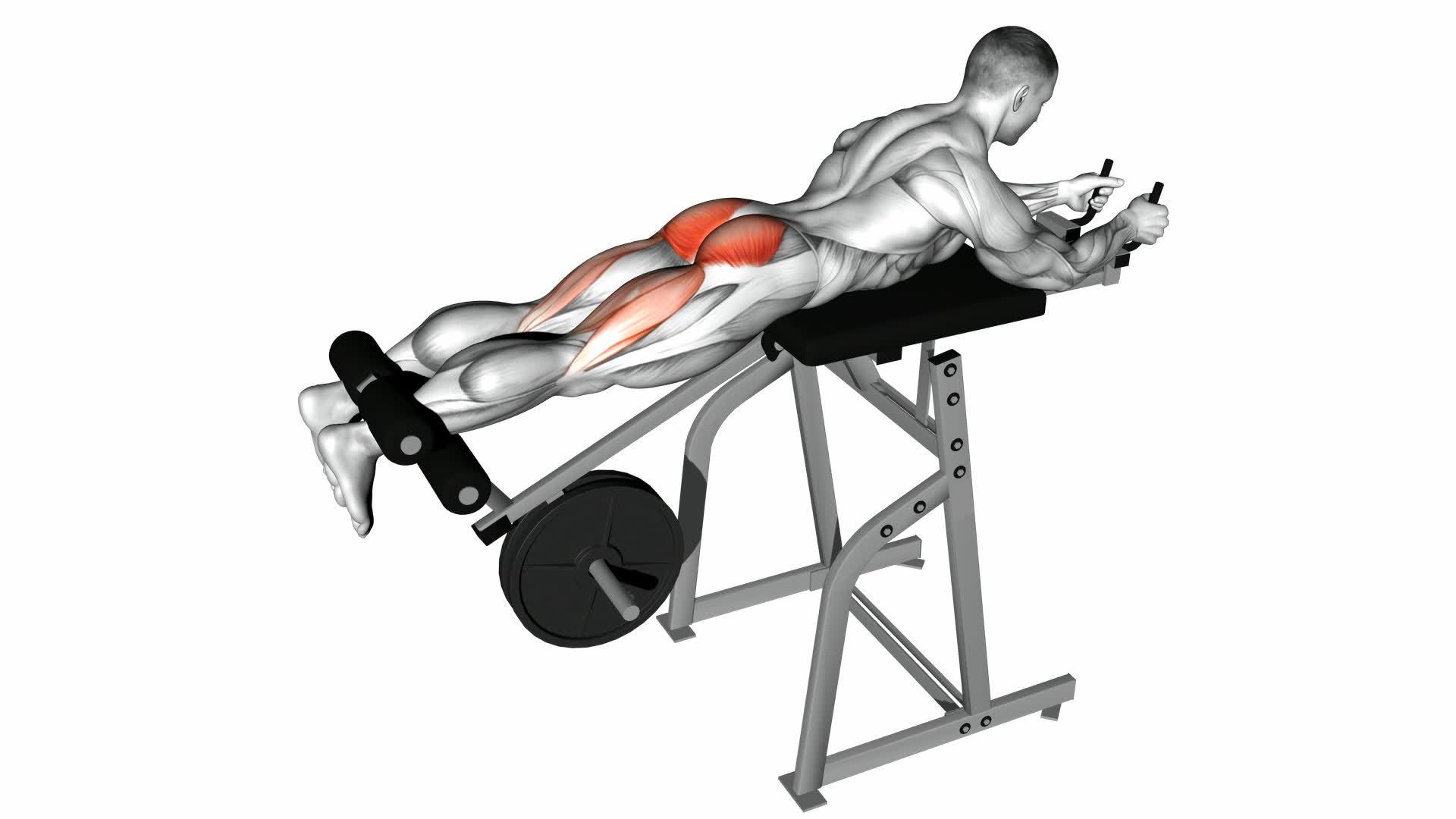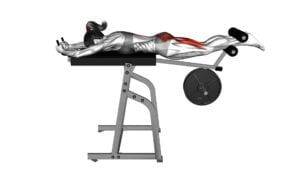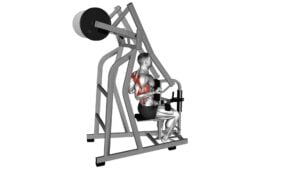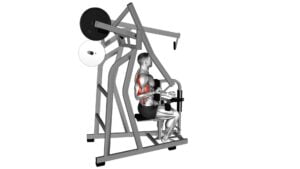Lever Reverse Hyperextension (Plate Loaded) – Video Exercise Guide & Tips

Looking to strengthen your lower back and glutes? Check out this video exercise guide and tips for the lever reverse hyperextension (plate loaded).
Watch This Exercise Video
This exercise targets your posterior chain, helping to improve stability and prevent injuries. Learn the proper set-up and equipment, correct form and technique, as well as tips for increasing intensity and progressing the exercise.
Avoid common mistakes and ensure your safety with the right modifications. Get ready to level up your workout with this effective exercise.
Key Takeaways
- The lever reverse hyperextension targets the lower back and glutes, strengthening the erector spinae muscles and increasing gluteus maximus strength.
- Proper form and technique, including engaging the core muscles and maintaining controlled tempo, are essential for maximizing effectiveness and preventing injury.
- Increasing intensity and progression can be achieved by adding weight plates, incorporating advanced variations, and continuously challenging the muscles.
- It is important to prioritize safety and injury prevention by maintaining proper positioning, avoiding hyperextension of the lower back, and consulting professionals for guidance, especially for individuals with pre-existing conditions or injuries.
Benefits of Lever Reverse Hyperextension
Discover the benefits of the Lever Reverse Hyperextension for your lower back and glutes.
The lever reverse hyperextension primarily targets the muscles in your lower back and glutes, making it an effective exercise for strengthening and toning these areas. By performing this exercise, you can specifically engage and activate the erector spinae muscles, which run along the length of your spine and play a vital role in maintaining proper posture and spinal stability. Additionally, the lever reverse hyperextension helps to strengthen the gluteus maximus, the largest muscle in your buttocks, which is crucial for hip extension and overall lower body strength.
Not only does the lever reverse hyperextension target these important muscle groups, but it also provides numerous benefits for your lower back. By strengthening the muscles in this area, you can improve your posture and reduce the risk of lower back pain and injury. The exercise also helps to increase spinal extension, which can alleviate tightness and discomfort in the lower back. Incorporating the lever reverse hyperextension into your workout routine can contribute to a stronger and more resilient lower back, allowing you to perform daily activities and other exercises with greater ease and efficiency.
Now that you understand the benefits of the lever reverse hyperextension, let's move on to the next section, where we'll discuss the proper set-up and equipment for plate loaded lever reverse hyperextension.
Proper Set-up and Equipment for Plate Loaded Lever Reverse Hyperextension
To ensure proper set-up and equipment for plate loaded lever reverse hyperextension, there are a few key points to keep in mind.
First, make sure the equipment is positioned correctly to provide stability and support during the exercise.
Second, use optimal setup techniques such as adjusting the height and angle of the machine to fit your body properly.
Equipment Positioning Tips
To properly set up and position the equipment for the plate loaded lever reverse hyperextension, always carefully and frequently adjust the seat, foot pads, and lever arm to ensure maximum effectiveness and comfort during your workout.
Start by adjusting the seat height so that your knees are aligned with the pivot point of the lever arm. This will allow for proper range of motion and prevent any strain on your lower back.
Next, adjust the foot pads so that they're snug against your ankles, providing stability and support.
Finally, adjust the lever arm to a position where it's parallel to the floor when your body is fully extended. This will ensure that you're targeting the correct muscle groups and performing the exercise with proper form.
Optimal Setup Techniques
Ensure that you properly position and set up the equipment for the plate loaded lever reverse hyperextension by following these optimal techniques.
To achieve optimal positioning, start by adjusting the footplate so that it aligns with the middle of your lower legs. Position yourself facing down on the pad, making sure your hips are aligned with the lever pivot point.
Place your feet against the footplate, with your toes pointing forward. Keep your upper body straight and grab the handles for stability.
Now, you're ready to perform the lever reverse hyperextension. Remember, there are various exercise variations you can try, such as adding weight plates or adjusting the footplate angle.
Experiment with different variations to target different muscle groups and intensify your workout.
Correct Form and Technique for Lever Reverse Hyperextension
When performing the Lever Reverse Hyperextension, it's important that you maintain proper form and technique. This exercise has various variations that you can incorporate to target different muscle groups and intensify your workout.
One common misconception about the lever reverse hyperextension is that it primarily works the lower back. In reality, this exercise targets the glutes, hamstrings, and even the core muscles.
To ensure correct form, start by adjusting the foot pad so that it aligns with your hip joint. Position yourself face down on the machine with your hips resting on the pad and your upper body extending beyond the machine.
Engage your core and squeeze your glutes as you lift your legs up towards the ceiling. Keep a controlled and slow tempo throughout the movement, focusing on using your glutes and hamstrings to lift your legs.
As you transition into the next section about tips for increasing intensity and progressing the exercise, remember to start with lighter weights and gradually increase the resistance as you become more comfortable with the movement.
Tips for Increasing Intensity and Progressing the Exercise
To increase the intensity and progress the lever reverse hyperextension exercise, you can incorporate the following tips and techniques.
- Consider increasing the resistance by adding weight plates to the machine. Start with a manageable weight and gradually increase it as you get stronger. This will challenge your muscles and help you build strength and endurance.
- Another way to increase the intensity is by incorporating advanced variations of the exercise. For example, you can perform the exercise with one leg at a time, which will engage your core and glutes even more. Alternatively, you can try performing the exercise on an unstable surface, such as a stability ball, to further challenge your balance and stability.
By incorporating these tips and techniques, you can continue progressing and making gains in your lever reverse hyperextension exercise.
Now, let's move on to the next section, where we'll discuss the common mistakes to avoid during lever reverse hyperextension.
Common Mistakes to Avoid During Lever Reverse Hyperextension
To avoid common mistakes during the lever reverse hyperextension exercise, be mindful of your form and technique. Here are some technique tips to help you perform the exercise correctly and safely:
- Positioning: Make sure your body is properly aligned before starting the exercise. Your hips should be positioned at the edge of the bench, and your upper body should be supported by your forearms on the pad.
- Range of motion: Avoid hyperextending your lower back during the movement. Instead, focus on a controlled and smooth motion, maintaining a neutral spine position throughout.
- Engaging your glutes: To maximize the effectiveness of the exercise, actively squeeze your glutes at the top of the movement. This will help target your glute muscles and prevent excessive stress on your lower back.
- Breathing: Remember to breathe properly throughout the exercise. Inhale as you lower your body and exhale as you raise it back up. This will help stabilize your core and maintain proper form.
Safety Precautions and Modifications for Lever Reverse Hyperextension
How can you ensure a safe and effective lever reverse hyperextension exercise? Safety modifications and injury prevention are essential aspects to consider when performing this exercise.
To ensure your safety, it's important to start with an appropriate weight load that allows you to maintain proper form throughout the movement. This will help prevent strain or injury to your lower back. Additionally, make sure to adjust the lever pad to the appropriate height, ensuring that your hips are aligned with the pad. This will help maintain stability and reduce the risk of injury.
It is also crucial to engage your core muscles throughout the exercise to provide support to your spine. This can be achieved by contracting your abdominal muscles and maintaining a neutral spine position. Avoid hyperextending your lower back, as this can put excessive stress on the lumbar region.
As with any exercise, it's important to listen to your body and stop immediately if you experience any pain or discomfort. If you have any pre-existing conditions or injuries, it's advisable to consult with a healthcare professional or fitness trainer before attempting this exercise.
Frequently Asked Questions
Can I Perform a Lever Reverse Hyperextension Exercise Without a Plate Loaded Machine?
Yes, you can perform lever reverse hyperextension variations without a plate loaded machine. By utilizing alternative methods such as bodyweight exercises or resistance bands, you can still reap the benefits of lever reverse hyperextension.
These variations target your lower back, glutes, and hamstrings, helping to strengthen and stabilize your core. Remember to maintain proper form and gradually increase the intensity to avoid injury.
Consult a fitness professional for guidance on alternative exercises.
How Often Should I Incorporate Lever Reverse Hyperextension Into My Workout Routine?
To incorporate lever reverse hyperextension into your strength training routine, consider doing it 2-3 times a week.
This exercise is great for improving core stability and targeting your lower back and glutes.
By regularly incorporating it into your workouts, you can strengthen these muscles and enhance your overall strength and stability.
Remember to start with a weight that challenges you but allows you to maintain proper form.
Can Lever Reverse Hyperextension Help With Lower Back Pain?
Lever reverse hyperextension can be beneficial for alleviating lower back pain. By strengthening the muscles in your lower back, this exercise helps provide support and stability to the spine.
To perform lever reverse hyperextension, lie face down on the machine, secure your feet under the pads, and slowly raise your upper body until your back is in a straight line. Remember to engage your core and avoid any jerky movements to maintain proper technique.
What Are Some Alternative Exercises That Target the Same Muscles as the Lever Reverse Hyperextension?
If you're looking for alternatives to the lever reverse hyperextension, there are a few exercises that target the same muscles.
One option is the glute bridge, which activates the glutes and hamstrings.
Another option is the bird dog exercise, which engages the core and lower back muscles.
Additionally, you can try the superman exercise, which strengthens the lower back and glutes.
These variations of lever reverse hyperextension exercises can help you work the same muscle groups in different ways.
Is the Lever Reverse Hyperextension Suitable for Beginners?
The lever reverse hyperextension can be suitable for beginners, but it's important to know the benefits and precautions.
This exercise targets your lower back and glutes, helping to improve strength and stability.
To start, use lighter weights and focus on proper form. As you progress, gradually increase the weight and range of motion.
Remember to listen to your body and modify the exercise if needed.
Consult a trainer for personalized guidance and support.
Conclusion
In conclusion, the lever reverse hyperextension is a beneficial exercise for strengthening the lower back and glutes. Proper set-up and equipment are important for performing the exercise safely and effectively.
Maintaining correct form and technique is key to getting the most out of the exercise. Increasing intensity and progressing the exercise can be achieved by adding weight or adjusting the angle.
It's important to avoid common mistakes and follow safety precautions for a successful workout.

Author
Years ago, the spark of my life’s passion ignited in my mind the moment I stepped into the local gym for the first time. The inaugural bead of perspiration, the initial endeavor, the very first surge of endorphins, and a sense of pride that washed over me post-workout marked the beginning of my deep-seated interest in strength sports, fitness, and sports nutrition. This very curiosity blossomed rapidly into a profound fascination, propelling me to earn a Master’s degree in Physical Education from the Academy of Physical Education in Krakow, followed by a Sports Manager diploma from the Jagiellonian University. My journey of growth led me to gain more specialized qualifications, such as being a certified personal trainer with a focus on sports dietetics, a lifeguard, and an instructor for wellness and corrective gymnastics. Theoretical knowledge paired seamlessly with practical experience, reinforcing my belief that the transformation of individuals under my guidance was also a reflection of my personal growth. This belief holds true even today. Each day, I strive to push the boundaries and explore new realms. These realms gently elevate me to greater heights. The unique combination of passion for my field and the continuous quest for growth fuels my drive to break new ground.



